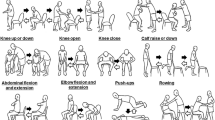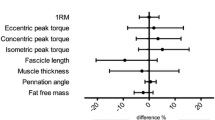Abstract
The aim of the study was to assess the effect of eccentric training using a constant load with longer exposure time at the eccentric phase on knee extensor muscle strength and functional capacity of elderly subjects in comparison with a conventional resistance training program. Twenty-six healthy elderly women (age = 67 ± 6 years) were randomly assigned to an eccentric-focused training group (ETG; n = 13) or a conventional training group (CTG; n = 13). Subjects underwent 12 weeks of resistance training twice a week. For the ETG, concentric and eccentric phases were performed using 1.5 and 4.5 s, respectively, while for CTG, each phase lasted 1.5 s. Maximum dynamic strength was assessed by the one-repetition maximum (1RM) test in the leg press and knee extension exercises, and for functional capacity, subjects performed specific tests (6-m walk test, timed up-and-go test, stair-climbing test, and chair-rising test). Both groups improved knee extension 1RM (24–26 %; p = 0.021), timed up-and-go test (11–16 %; p < 0.001), 6-m walk test (9–12 %; p = 0.004), stair-climbing test (8–13 %; p = 0.007), and chair-rising test (15–16 %; p < 0.001), but there was no significant difference between groups. In conclusion, the strategy of increasing the exposure time at the eccentric phase of movement using the same training volume and intensity does not promote different adaptations in strength or functional capacity compared to conventional resistance training in elderly woman.


Similar content being viewed by others
References
Aagaard P, Suetta C, Caserotti P, Magnusson SP, Kjaer M (2010) Role of the nervous system in sarcopenia and muscle atrophy with aging: strength training as a countermeasure. Scand J Med Sci Sports 20:49–64
ACSM. American College of Sports Medicine position stand (2009) Progression models in resistance training for healthy adults. Med Sci Sports Exerc 41:687–708
Brockett CL, Morgan DL, Proske U (2001) Human hamstring muscles adapt to eccentric exercise by changing optimum length. Med Sci Sports Exerc 33:783–790
Brown LE, Weir JP (2001) ASEP procedures recommendation I: accurate assessment of muscular strength and power. JEP Online 4:1–21
Cadore EL, Pinto RS, Kruel LFM (2012) Neuromuscular adaptations to strength and concurrent training in elderly men. Braz J Kin Hum Perform 14:483–495
Cuoco A, Callahan CM, Sayers S, Frontera WR, Bean J, Fielding RA (2004) Impact of muscle power and force on gait speed in disabled older men and women. J Gerontol A Biol Sci Med Sci 59:1200–1206
DiPietro L (2001) Physical activity in aging: changes in patterns and their relationship to health and function. J Gerontol A Biol Sci Med Sci 56:13–22
Ellaway H, Taylor A, Durbaba R (2015) Muscle spindle and fusimotor activity in locomotion. J Anat 227:157–166
Friedmann-Bette B, Bauer T, Kinscherf R, Vorwald S, Klute K, Bischoff D, Muller H, Weber MA, Metz J, Kauczor HU, Bartsch P, Billeter R (2010) Effects of strength training with eccentric overload on muscle adaptation in male athletes. Eur J Appl Physiol 108:821–836
Galvão DA, Taaffee DR (2005) Resistance exercise dosage in older adults: single-versus multiset effects on physical performance and body composition. J Am Geriatr Soc 53:2090–2097
Garber CE, Blissmer B, Deschenes MR, Franklin BA, Lamonte MJ, Lee IM, Swain DP (2011) American College of Sports Medicine position stand. Quantity and quality of exercise for developing and maintaining cardiorespiratory, musculoskeletal, and neuromotor fitness in apparently healthy adults: guidance for prescribing exercise. Med Sci Sports Exerc 43:1334–1359
Gault ML, Willems ME (2013) Aging, functional capacity and eccentric exercise training. Aging Dis 4:351–363
Gault ML, Clements RE, Willems ME (2012) Functional mobility of older adults after concentric and eccentric endurance exercise. Eur J Appl Physiol 112:3699–3707
Guilhem G, Cornu C, Guevel A (2010) Neuromuscular and muscle-tendon system adaptations to isotonic and isokinetic eccentric exercise. Ann Phys Rehabil Med 53:319–341
Gür H, Çakin N, Akova B, Okay E, Küçükoglu S (2002) Concentric versus combined concentric-eccentric isokinetic training: effects on functional capacity and symptoms in patients with osteoarthrosis of the knee. Arch Phys Med Rehabil 83:308–316
Häkkinen K, Pakarinen A (1994) Serum hormones and strength development during strength training in middle-aged elderly males and females. Acta Physiol Scand 150:211–219
Hanson ED, Srivatsan SR, Agrawal S, Menon KS, Delmonico MJ, Wang MQ, Hurley BF (2009) Effects of strength training on physical function: influence of power, strength, and body composition. J Strength Cond Res 23:2627–2637
Henwood TR, Taaffe DR (2005) Improved physical performance in older adults undertaking a short-term programme of high-velocity resistance training. J Gerontol 51:108–115
Hickson R, Hidaka C, Foster C, Falduto M, Chaterton R (1994) Sucessive time courses of strength development and steroid hormone responses to heavy-resistance training. J Appl Physiol 76:663–670
Issurin VB (2013) Training transfer: scientific background and insights for practical application. Sports Med 43:675–694
Kalapotharakos VI, Michalopoulos M, Tokmakidis SP, Godolias G, Gourgoulis V (2005) Effects of a heavy and a moderate resistance training on functional performance in older adults. J Strength Cond Res 19:652–657
Lastayo PC, Woolf JM, Lewek MD, Snyder-Mackler L, Reich T, Lindstedt SL (2003) Eccentric muscle contractions: their contribution to injury, prevention, rehabilitation, and sport. J Orthop Sports Phys Ther 33:557–571
Levinger I, Goodman C, Hare DL, Jerums G, Toia D, Selig S (2009) The reliability of the 1RM strength test for untrained middle-aged individuals. J Sci Med Sport 12:310–316
Macaluso A, De Vito G (2004) Muscle strength, power and adaptations to resistance training in older people. Eur J Appl Physiol 91:450–472
Melo RC, Quiterio RJ, Takahashi AC, Silva E, Martins LE, Catai AM (2008) High eccentric strength training reduces heart rate variability in healthy older men. Br J Sports Med 42:59–63
Mueller M, Breil FA, Vogt M, Steiner R, Lippuner K, Popp A, Klossner S, Hoppeler H, Dapp C (2009) Different response to eccentric and concentric training in older men and women. Eur J Appl Physiol 107:145–153
MuellerM BFA, Lurman G, Klossner S, Fluck M, Billeter R, Dapp C, Hoppeler H (2011) Different molecular and structural adaptations with eccentric and conventional strength training in elderly men and women. J Gerontol 57:528–538
Onambele GL, Maganaris CN, Mian OS, Tam E, Rejc E, Mcewan IM, Narici MV (2008) Neuromuscular and balance responses to flywheel inertial versus weight training in older persons. J Biomech 41:3133–3138
Peiffer JJ, Galvão DA, Gibbs Z, Smith K, Turner D, Foster J, Newton RU (2010) Strength and functional characteristics of men and women 65 years and older. Rejuvenation Res 13:75–82
Pinto RS, Correa CS, Radaelli R, Cadore EL, Brown LE, Bottaro M (2013) Short-term strength training improves muscle quality and functional capacity of elderly women. AGE 36:365–372
Purtsi J, Vihko V, Kankaanpaa A, Havas A (2012) The motor-learning process of older adults in eccentric bicycle ergometer training. J Aging Phys Act 20:345–362
Raj IS, Bird SR, Westfold BA, Shield AJ (2012) Effects of eccentrically biased versus conventional weight training in older adults. Med Sci Sports Exerc 44:1167–1176
Reeves ND, Maganaris CN, Longo S, Narici MV (2009) Differencial adaptations to eccentric versus conventional resistence training in older humans. Exp Physiol 94:825–833
Rice J, Keogh JWL (2009) Power training: can it improve functional perfomance in older adults? A systematic review. Int J ExercSci 2:131–151
Roig M, O'Brien K, Kirk G, Murray R, McKinnon P, Shadgan B, Reid WD (2009) The effects of eccentric versus concentric resistance training on muscle strength and mass in healthy adults: a systematic review with meta-analysis. Br J Sports Med 43:556–568
Schoenfeld BJ (2010) The mechanisms of muscle hypertrophy and their application to resistance training. J Strength Cond Res 24:2857–2872
Schroeder ET, Hawkins SA, Jaque SV (2004) Musculoskeletal adaptations to 16 weeks of eccentric progressive resistance training in young women. J Strength Cond Res 18:227–235
Serra-Rexach JA, Bustamante-Ara N, Villarán MH, Gil PG, Ibáñez MJS, Blanco Sanz NBM, Santamaría VO, Guriérrez Sanz N, Prada ABM, Gallardo C, Romo GR, Ruiz JR, Lucia A (2011) Short-term, light- to moderate-intensity exercise training improves leg muscle strength in the oldest old: a randomized controlled trial. J Am Geriatr Soc 59:594–602
Seynnes O, Singh MAF, Hue O, Pras P, Legros P, Bernard PL (2004) Physiological and functional responses to low-moderate versus high intensity progressive resistance training in frail elders. J Gerontol A Biol Sci Med Sci 59:503–509
Symons TB, Vandervoort AA, Rice CL, Overend TJ, Marsh GD (2005) Effects of maximal isometric and isokinetic resistance training on strength and functional mobility in older adults. J Gerontol A Biol Sci Med Sci 60:777–781
Tiedemann A, Shimada H, Sherrington C, Murray S, Lord S (2008) The comparative ability of eight functional mobility tests for predicting falls in community-dwelling older people. Age Ageing 37:430–435
Tiggemann CL, Korzenowski AL, Brentano MA, Tartaruga MP, Alberton CL, Kruel LF (2010) Perceived exertion in different strength exercise loads in sedentary, active, and trained adults. J Strength Cond Res 24:2032–2041
Valour D, Rouji M, Pousson M (2004) Effects of eccentric training on torque-angular velocity-power characteristics of elbow flexor muscles in older women. Exp Gerontol 39:359–368
Wernbom M, Augustsson J, Thomee R (2007) The influence of frequency, intensity, volume and mode of strength training on whole muscle cross-sectional area in humans. Sports Med 37:225–264
Westing SH, Cresswell AG, Thorstensson A (1991) Muscle activation during maximal voluntary eccentric and concentric knee extension. Eur J Appl Physiol Occup Physiol 62:104–108
Acknowledgments
We would like to thank the Faculty of Serra Gaucha for the support and providing the gymnastic facility for the study.
Author information
Authors and Affiliations
Corresponding author
About this article
Cite this article
Dias, C.P., Toscan, R., de Camargo, M. et al. Effects of eccentric-focused and conventional resistance training on strength and functional capacity of older adults. AGE 37, 99 (2015). https://doi.org/10.1007/s11357-015-9838-1
Received:
Accepted:
Published:
DOI: https://doi.org/10.1007/s11357-015-9838-1




